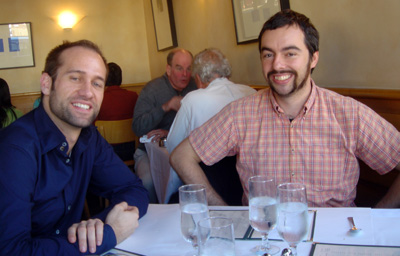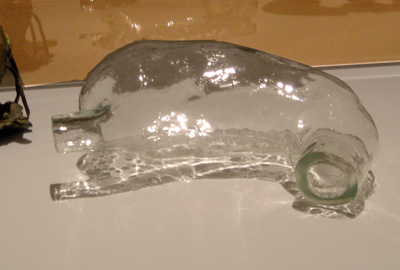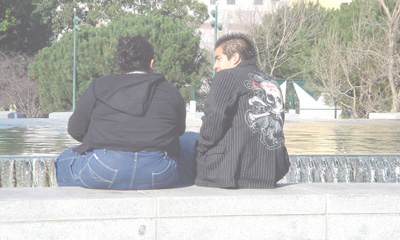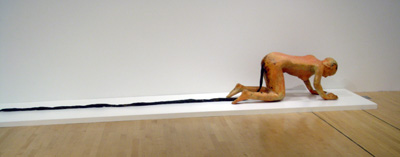
[Chief Execs of Monkeybrains, Inc., spotted at Fringale in San Francisco.]
Wondering about the relationship between humans and the net-based super-AI beezie beings, I’ve been thinking about an article by John Walker, “Computation, Memory, Nature, and Life”. He argues that life (and presumably intelligence) requires “digital storage”. Examples of what he calls digital storage in nature are: DNA, the human brain’s neural net, and the immune systems of vertebrates.

In Walker's words, “The fluttering of leaves in the wind, the ripples of water in a stream, the boiling of clouds over a mountain range, the intricate N-body ballet of stars orbiting the centre of mass of galaxy, all have no storage apart from their instantaneous analogue state space–they have no way to store and retrieve information in a robust and reliable digital form. Hence … these are not universal computations. They may be chaotic and unpredictable, but they can't be used in any manner to emulate any other computation, and therefore cannot be said to be equivalent to other computations or universal.”

[This shows a glass stomach made by artist Kiki Smith, part of her cool show at SFMOMA.]
I think it’s an interesting and suggestive argument, but I don't really think it's absolutely true. I tend to think that, e.g., sunspots could be alive, and reproduce, and eat each other, and even behave adaptively (as in Frek and the Elixir). But maybe in those sunspot tubes, there were certain long-lived vortex knot patterns functioning as a digital storage form, in which case Walker would still be on safe ground.

This picture, taken at one of my favorite resting spots in Yerba Buena Gardens in SF the other day, has several interesting features. The couple might be my characters Kittie and Sonic. I like the hairstyle of using enough gel to digitize your hair into a small number of distinct peaks. Check out the cool skull that the guy has hand-painted onto his wool suit jacket
And note the bumps of water meandering back and forth at the lip of the waterfall. I see these bumps as a class-four computation. And it seems like you could make them universal (assuming you idealized to make the waterfall arbitrarily wide) by forcing some bump pattern in and watching what happens. It's just a matter of emulation, innit? So I think you can have universality without digital storage, at least not in an obvious form. Although here, again, the info can be viewed as stored in the form of glider-like patterns of wave-bumps moving left and right.

Looking ahead, I’d like to think of the beezies as migrating out of the web and into the actual paracomputation of the world. Whether or not Walker is right in an absolute sense, he’s certainly right in the more limited sense that the computational speed and power of a natural process could be improved by somehow integrating RAM. I’m thinking of some string-theory method of attaching a little bit of RAM-brane to, like, streams and clouds. Animism made real.

[Totally gnarly piece by Kiki Smith called “Tale.” Funny for a novelist to see; thinking of how one crawls along, eating one’s way through life, extruding the long tale. But — ugh. Gotta hand it to women, they really can be gnarlier than men!]
Of course my all-purpose Presidential villian Dick Too Dodd (known as Joe Doakes in Mathematicians in Love) will want to damp all of this down. He claims he’s for a return to the old pre-orphidnet ways, but really, he wants to smash Earth into a Dyson Sphere of computronium where he can reign as a God.
As my character Kittie might put it, “Capitalists want people to be like sheep, and easy to fleece. Therefore they are against personal freedom, against quirky indigenous cultures, against self-expression, and against any non-goal-directed education. They want mass mind they can mass process. Like firm, tasteless, easy-to-harvest tomatoes.”









January 10th, 2006 at 9:04 am
Very, garnly picture. I was up in the city yesterday, I should have gone to the show.
I think Walker is guilty of an anthropomorphic view of life. I think all memory means is that the previous state of the system affects future states.
If he reduced his argument to life like us that we might be able to talk with, it would be more viable. Not that there is any other kind of life, but we would know it in any case.
January 11th, 2006 at 11:09 am
Rudy, I just read an extremely gnarly short piece by Greg Egan that ties into what you’re saying here. It was in Hartwell&Broderick’s Aussie SF collection CENTAURUS and called ‘Carpets of Wang,’ and concerned a waterworld full of jellyfish running computations which decoded into a varied ecology of virtual creatures.
I recall reading that certain pieces of turned pottery can accidentally store the sound of the pottery wheel and murmuring voices, if you have the right equipment to play them back.
Also, if you took two of those ‘Tales’ and put them in a straight line it would symbolize the kind of slavery to capitalism your characters fear. But cheer up, all is not completely bleak; some capitalists fund things like Monkeybrains!
February 1st, 2006 at 11:13 pm
I want that guys coat……, please.